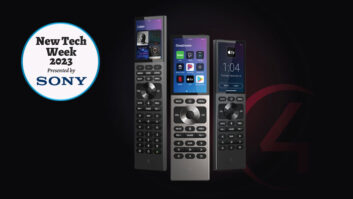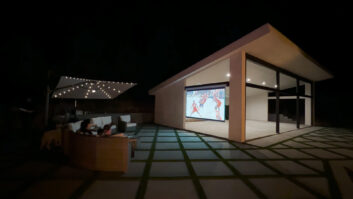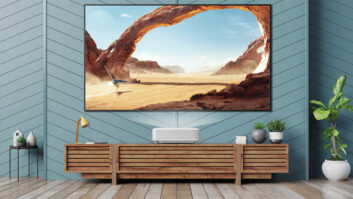It doesn’t seem that long ago that 5.1 surround was the ultimate in home theater audio. Now, to some, it’s looking like just the beginning. Tomlinson Holman, one of the founding fathers of multichannel audio, once commented that 5.1–the terminology that he coined in 1987 for the consumer version of the 6-track split-surround format in use on 70- mm film consisting of an L-C-R array, two stereo rear channels and a low-frequency effects (LFE) channel–was “the minimum number of channels necessary to give a sense of spaciousness.” Holman, never one to mince anything, much less audio, has speculated on audio channel counts ranging from the 30 referenced by Jens Blauert in the book Spatial Hearing to a British mathematician’s suggestion that an even one-million channels would be necessary to properly approximate human aural perception. Although Holman conceded that an AT&T scientist’s estimate of 10,000 might be sufficient. By comparison, surround configurations like 7.1, 10.2, and the 22.2 configuration developed by NHK seem downright reasonable.
The Integrator Experience
Going beyond 5.1 is still relatively rare, and most of that has been into the 7.1 domain, which is increasingly addressed by consumer manufacturers with amplifiers and processors that accommodate that channel configuration. Josh Christian, vice president of marketing for DSI Entertainment Systems in Los Angeles, said that he’s done nearly a dozen 7.1 projects thus far, increasingly using multiple subwoofers on the LFE channel, placing them in corners to boost the low end without making the subs any louder and using the JBL Synthesis SDEC-4500, which can configure up to 12 channels, and the S4300XLRIC interconnect kit to add balanced equalization across all channels.
“The 4500 is useful for this many channels because I’m able to apply the EQ across more channels, including across all the subs, which helps with placement,” he explained.
In fact, Christian added, he’s been a disciple of multiple subs based on the work of Dr. Floyd Toole, whose “magic number,” as Christian described it, of four subwoofers to better distribute low frequencies around a theater, meshes well with the idea of more overall audio channels. “It’s a smoother effect across the entire spectrum in the room when you’re at 7.1,” he said.
Like other integrators, Blair Robin and Ron Perruzza, partners in Radiant Audio Design in Mississauga, Ontario, have plenty of 5.1 installations under their belt and are just moving into 7.1, with two projects finished–one of which is their own showroom, underscoring how tentative consumer uptake of surround beyond 5.1 has been so far. A 9.11 (yes, 11 subwoofers) project is also under way.
“We’re getting some resistance” beyond 5.1, Perruzza said, much of it based on costs of additional speakers and higher-end receivers and processing but some also coming from innate consumer concerns about the viability of what are still exotic formats.
“A lot of people feel it might be a fad,” Perruzza explained. “They see other formats changing; they had to go from HDMI 1.3 to 1.4 for 3D, and they wonder how viable that format’s going to be in the long run. I understand their frustrations.”

Like other integrators, Blair Robin and Ron Perruzza, partners in Radiant Audio Design in Mississauga, Ontario, have plenty of 5.1 installations under their belt and are just moving into 7.1, with two projects finished–one of which is their own showroom, underscoring how tentative consumer uptake of surround beyond 5.1 has been so far.Nonetheless, there are clients who want to be on the edge, and for their first 10.2 system Perruzza and partner Blair Robin chose a California Audio Technologies speakers and digital amplifiers with a Bryston SB3 processor, SIM2 video projection, configuring the in-wall speakers (all bi-wired except the L-C-R, which is tri-wired for three amplifiers) as L-C-R, two pairs above the front array, three rear speakers, two on the side walls and a total of 11 subwoofers–seven across the front and two each on the side walls.
It Takes More Planning
Other integrators that are working on their first 10.2 systems find that fitting such larger systems into theaters takes some strategic planning. Mark van den Broek, owner of SmartHouse Integration in Sarasota, FL, said there are few resources he’s found to guide him, and that the extensive glass surfaces favored by Florida’s residential architecture often complicates acoustics. Now in the planning stages of his first 10.2 system, he’s weighing componentry decisions between speaker brands, but also accommodating the room’s characteristics by emphasizing the “height” channels atop the L-C-R array versus side channels.
“I think we’ll get a better effect out of the upper speakers firing downward and aimed right at the seating area, with some dipoles on the wall rather than using in-walls on the sides,” he said.
Some integrators see the Babel of multichannel audio beyond 5.1 as temporary collateral problems to what they view as the inevitable arrival of immersive home theater audio. “We’re doing more than just selling more equipment; we’re putting the foundation in place to future-proof the home theater,” said Anthony Grimani, president of PMI Ltd, in Novato, CA, a company that engineers high-end theaters and screening rooms. Grimani said that certain additional new channel configurations, such as height channels, are becoming more common. “It’s been going on since Dolby Surround EX came out for The Phantom Menace,” he said referencing Dolby’s format modification for Dolby Digital in which the center-channel information is also reproduced by speakers that are placed directly behind the audience, and citing companies like Barcelona-based imm Sound, which has married configurations ranging from 14.1 to 32.1 and higher to 3D films in commercial cinemas.
“How many speakers we’ll eventually wind up with is unknown, but the future is clearly pointing to more channels,” he said. “As screens get bigger and projectors get brighter, we need more channels to resolve the audio more accurately to the screen.”
Until that future figures itself out, some theater designers, like Sam Cavitt, owner of Paradise Theater in Maui, HI, are laying groundwork for theater expansions down the road. “We’re putting ‘dark’ wiring or conduit in place for additional high or wide speaker pairs in many new theaters,” he explained. Cavitt is also splitting the LFE channel into at least four separate feeds around the room.
Content
A big concern among integrators and clients is lack of content specifically tailored for formats larger than 5.1. Blu-ray supports 7.1, with Disney’s Toy Story 3 the first title mixed for discrete 7.1. That movie was followed by titles including Tron: Legacy, Tangled, Megamind, Kung Fu Panda 2, Super 8, Cars 2, and others. Dolby maintains a website that lists many current and upcoming titles in 7.1. Beyond 7.1, however, there are only a handful of specialty titles.
Nonetheless, key AV vendors aren’t waiting for the studios. On the hardware side, Pioneer, Onkyo, and Denon have 9.1 AV receivers on the market. Audio processing format developers are backing so-called derived-surround formats. Last September Harman introduced QuantumLogic Surround (QLS), which can upmix any source, including mono and stereo, to 7.1, 9.1, or 12.1 using Harman’s Lexicon MP-20 preamplifier/ surround processor. The QLS processor operates on a frequency basis to fabricate additional height channels (as many as five using the MP-20), as well as extracting reverberation information from the original source and recreating multiple channels of reverberation for redistribution.
DTS’ Neo:X can create up to 32 different input/ output upmixed combinations for configurations of 2.0 through 11.1, which offers both height and extra width stereo pairs, with preset configuration modes for movies, music, and games. Alan Cohen, DTS’ vice president of marketing, said that Sony, Pioneer, Onkyo, and Denon all support up to 9.1 iteration of the format thus far. Geir Skaaden, senior vice president of products and platforms at DTS, said that demand is being driven by the uptake of 3D television and increased-resolution displays. “Studios are looking for ways to make their audio match the better picture,” he noted.
Dolby has offered several solutions to deliver 7.1 in the absence of discrete content. Dolby Pro Logic IIx, introduced in 2004, has expanded upon the 5.1 experience by adding two additional surround back speakers, to create a more seamless surround experience for audio elements panned behind the listener. Three years ago, Dolby launched Pro Logic IIz, which introduced the concept of height to the home theater experience. AV receivers equipped with Pro-logic IIz can actually be set up for two different 7.1 configurations–the more traditional 7.1 configuration with three front speakers and four surrounds (Pro Logic IIx) or a configuration that employs a traditional 5.1 surround setup, and adds two front height speakers positioned directly above the left and right main speakers. Content can actually be mixed for PLIIz height playback; in the absence of dedicated height-channel information, the PLIIz system performs a blind upmix of non-directional audio elements to create a more immersive listening experience. Dolby Pro Logic IIz can also be integrated as a 9.1 speaker configuration, incorporating the traditional 7.1 layout and adding two front height speakers.
Craig Eggers, director of home theater marketing for Dolby, said that, “The driving force for Pro Logic IIz was to introduce a third dimension to the soundstage, providing a more immersive experience, while simultaneously maintaining the integrity of the original mix.”
Of course, the proliferation of audio channels in these formats has to be viewed in the context of a consumer electronics industry experiencing evertighter product cycles that demand novelty and at least the illusion of innovation.
It’s hard to know where the arms race of multichannel home cinema audio is going to top out, or if there will even be any kind of consensus when it comes to the number and nature of new channels. But it seems that 5.1 is rapidly headed to the status of “quaint” in the not-too-distant future.
Dan Daley is a freelance writer based in Nashville, TN.







